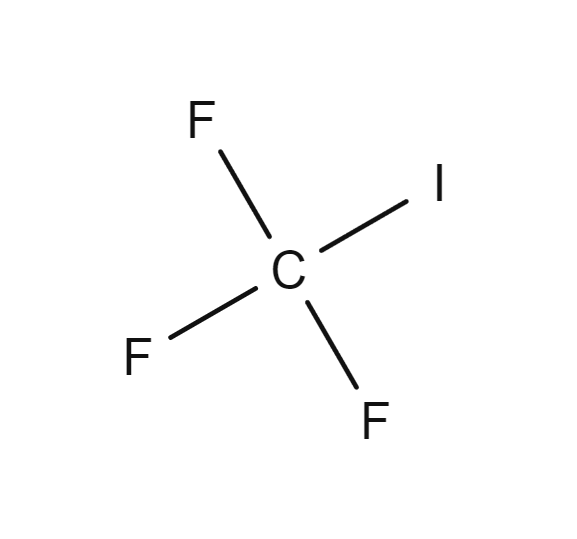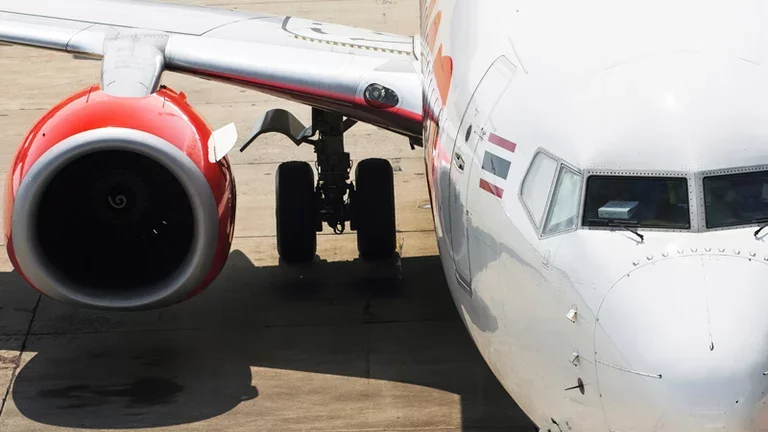
Trifluoroiodomethane
- CF3I
- CAS Number 2314-97-8
- UN1956 (gas)
Click & drag to move the 3D molecule
Liquid / Gas Volumes
Calculate the volume or mass of a quantity of gas or liquid
Liquid Phase
At boiling point at 1.013 bar
Gas Phase
In standard conditions (1.013 bar, 15°C)
Physical Properties
Molecule phase diagram showing the transition phases between solid, liquid and gas as a function of temperature and pressure
-
- Molar mass 195.910 g/mol
- Content in dry air /
-
Critical Point
- Temperature 123.29 °C
- Pressure 39.53 bar
- Density 869.57 kg/m³
-
Triple Point
- Temperature -78.00 °C
- Pressure 4.87E-2 bar
Pressure 1.013 bar
| Latent heat of fusion (at melting point) | 35.067 kJ/kg |
| Melting point | - 78 °C |
Pressure 1.013 bar
| Boiling point | - 21.85 °C |
| Latent heat of vaporization (at boiling point) | 103.962 kJ/kg |
| Liquid density (at boiling point) | 2248.9 kg/m3 |
| Compressibility factor Z | 9.6947E-1 |
| Cp/Cv ratio γ | 1.1688 |
| Gas density (at boiling point) | 9.909 kg/m3 |
| Gas density | 9.0159 kg/m3 |
| Gas/(liquid at boiling point) equivalent | 254.81 vol/vol |
| Heat capacity Cp | 3.4186E-1 kJ/(kg.K) |
| Heat capacity Cv | 2.925E-1 kJ/(kg.K) |
| Specific gravity | 6.9 |
| Specific volume | 1.109E-1 m3/kg |
| Thermal conductivity | 5.978 mW/(m.K) |
| Viscosity | 1.3003E-4 Po |
| Compressibility factor Z | 9.7475E-1 |
| Cp/Cv ratio γ | 1.1603 |
| Gas density | 8.5003 kg/m3 |
| Gas/(liquid at boiling point) equivalent | 270.27 vol/vol |
| Heat capacity Cp | 3.4725E-1 kJ/(kg.K) |
| Heat capacity Cv | 2.9928E-1 kJ/(kg.K) |
| Specific gravity | 6.9 |
| Specific volume | 1.177E-1 m3/kg |
| Thermal conductivity | 6.459 mW/(m.K) |
| Viscosity | 1.377E-4 Po |
| Compressibility factor Z | 9.7759E-1 |
| Cp/Cv ratio γ | 1.1557 |
| Gas density | 8.1913 kg/m3 |
| Gas/(liquid at boiling point) equivalent | 280.46 vol/vol |
| Heat capacity Cp | 3.5084E-1 kJ/(kg.K) |
| Heat capacity Cv | 3.0357E-1 kJ/(kg.K) |
| Specific gravity | 6.9 |
| Specific volume | 1.221E-1 m3/kg |
| Thermal conductivity | 6.779 mW/(m.K) |
| Viscosity | 1.4276E-4 Po |
Applications
Examples of uses of this molecule in Industry and Healthcare

Aeronautics
Trifluoroiodomethane would be used as a gaseous fire suppression flooding agent for in-flight aircraft and electronic equipment fires.
Safety & Compatibility
GHS04
Gas under pressure
GHS06
Acute Toxicity
Metals
| Aluminium | No data |
| Brass | No data |
| Monel | No data |
| Copper | No data |
| Ferritic Steel | No data |
| Stainless steel | No data |
| Zinc | No data |
| Titanium | No data |
Plastics
| Polytetrafluoroethylene | No data |
| Polychlorotrifluoroethylene | No data |
| Polyvinylidene fluoride | No data |
| Polyvinyl chloride | No data |
| Ethylene tetrafluoroethylene | No data |
| Polycarbonate | No data |
| Polyamide | No data |
| Polypropylene | No data |
Elastomers
| Butyl (isobutene- isoprene) rubber | No data |
| Nitrile rubber | No data |
| Chloroprene | No data |
| Chlorofluorocarbons | No data |
| Silicone | No data |
| Perfluoroelastomers | No data |
| Fluoroelastomers | No data |
| Neoprene | No data |
| Polyurethane | No data |
| Ethylene-Propylene | No data |
Lubricants
| Hydrocarbon based lubricant | No data |
| Fluorocarbon based lubricant | No data |
Materials compatibility
Learn More
More information
Due to their ozone-depleting effect, the production of refrigerants is continuously decreasing, based on Montreal protocol requirements. Their use is controlled and they are progressively being replaced.